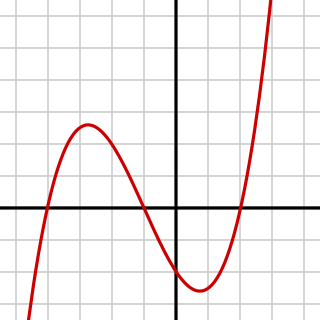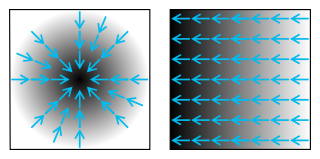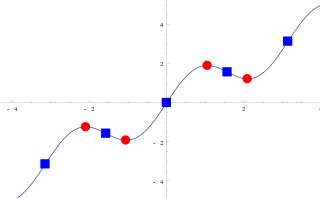 W
WIn mathematics, differential calculus is a subfield of calculus that studies the rates at which quantities change. It is one of the two traditional divisions of calculus, the other being integral calculus—the study of the area beneath a curve.
 W
WIn mathematics and computer algebra, automatic differentiation (AD), also called algorithmic differentiation, computational differentiation, auto-differentiation, or simply autodiff, is a set of techniques to numerically evaluate the derivative of a function specified by a computer program. AD exploits the fact that every computer program, no matter how complicated, executes a sequence of elementary arithmetic operations and elementary functions. By applying the chain rule repeatedly to these operations, derivatives of arbitrary order can be computed automatically, accurately to working precision, and using at most a small constant factor more arithmetic operations than the original program.
 W
WIn mathematics, the derivative of a function of a real variable measures the sensitivity to change of the function value with respect to a change in its argument. Derivatives are a fundamental tool of calculus. For example, the derivative of the position of a moving object with respect to time is the object's velocity: this measures how quickly the position of the object changes when time advances.
 W
WIn calculus, a differentiable function of one real variable is a function whose derivative exists at each point in its domain. In other words, the graph of a differentiable function has a non-vertical tangent line at each interior point in its domain. A differentiable function is smooth and does not contain any break, angle, or cusp.
 W
WIn mathematics, a differential-algebraic system of equations (DAEs) is a system of equations that either contains differential equations and algebraic equations, or is equivalent to such a system. Such systems occur as the general form of differential equations for vector–valued functions x in one independent variable t,
 W
WThe differentiation of trigonometric functions is the mathematical process of finding the derivative of a trigonometric function, or its rate of change with respect to a variable. For example, the derivative of the sine function is written sin′(a) = cos(a), meaning that the rate of change of sin(x) at a particular angle x = a is given by the cosine of that angle.
 W
WIn mathematics, especially real analysis, a flat function is a smooth function ƒ : ℝ → ℝ all of whose derivatives vanish at a given point x0 ∈ ℝ. The flat functions are, in some sense, the antitheses of the analytic functions. An analytic function ƒ : ℝ → ℝ is given by a convergent power series close to some point x0 ∈ ℝ:
 W
WA fluent is a time-varying quantity or variable. The term was used by Isaac Newton in his early calculus to describe his form of a function. The concept was introduced by Newton in 1665 and detailed in his mathematical treatise, Method of Fluxions. Newton described any variable that changed its value as a fluent – for example, the velocity of a ball thrown in the air. The derivative of a fluent is known as a fluxion, the main focus of Newton's calculus. A fluent can be found from its corresponding fluxion through integration.
 W
WA fluxion is the instantaneous rate of change, or gradient, of a fluent at a given point. Fluxions were introduced by Isaac Newton to describe his form of a time derivative. Newton introduced the concept in 1665 and detailed them in his mathematical treatise, Method of Fluxions. Fluxions and fluents made up Newton's early calculus.
 W
WIn vector calculus, the gradient of a scalar-valued differentiable function f of several variables is the vector field whose value at a point is the vector whose components are the partial derivatives of at . That is, for , its gradient is defined at the point in n-dimensional space as the vector:
 W
WIn mathematics, a hyperbolic angle is a geometric figure that defines a hyperbolic sector. The relationship of a hyperbolic angle to a hyperbola parallels the relationship of an "ordinary" angle to a circle.
 W
WIn differential calculus and differential geometry, an inflection point, point of inflection, flex, or inflection is a point on a smooth plane curve at which the curvature changes sign. In particular, in the case of the graph of a function, it is a point where the function changes from being concave to convex, or vice versa.
 W
WInstitutiones calculi differentialis is a mathematical work written in 1748 by Leonhard Euler and published in 1755 that lays the groundwork for the differential calculus. It consists of a single volume containing two internal books; there are 9 chapters in book I, and 18 in book II.
 W
WIn calculus, Leibniz's notation, named in honor of the 17th-century German philosopher and mathematician Gottfried Wilhelm Leibniz, uses the symbols dx and dy to represent infinitely small increments of x and y, respectively, just as Δx and Δy represent finite increments of x and y, respectively.
 W
WIn mathematics, a linear approximation is an approximation of a general function using a linear function. They are widely used in the method of finite differences to produce first order methods for solving or approximating solutions to equations.
 W
WMethod of Fluxions is a book by Isaac Newton. The book was completed in 1671, and published in 1736. Fluxion is Newton's term for a derivative. He originally developed the method at Woolsthorpe Manor during the closing of Cambridge during the Great Plague of London from 1665 to 1667, but did not choose to make his findings known. Gottfried Leibniz developed his form of calculus independently around 1673, 7 years after Newton had developed the basis for differential calculus, as seen in surviving documents like “the method of fluxions and fluents..." from 1666. Leibniz however published his discovery of differential calculus in 1684, nine years before Newton formally published his fluxion notation form of calculus in part during 1693. The calculus notation in use today is mostly that of Leibniz, although Newton's dot notation for differentiation for denoting derivatives with respect to time is still in current use throughout mechanics and circuit analysis.
 W
WIn numerical analysis, numerical differentiation describes algorithms for estimating the derivative of a mathematical function or function subroutine using values of the function and perhaps other knowledge about the function.
 W
WIn mathematics, an ordinary differential equation (ODE) is a differential equation containing one or more functions of one independent variable and the derivatives of those functions. The term ordinary is used in contrast with the term partial differential equation which may be with respect to more than one independent variable.
 W
WIn calculus, the second derivative, or the second order derivative, of a function f is the derivative of the derivative of f. Roughly speaking, the second derivative measures how the rate of change of a quantity is itself changing; for example, the second derivative of the position of an object with respect to time is the instantaneous acceleration of the object, or the rate at which the velocity of the object is changing with respect to time. In Leibniz notation:
 W
WIn mathematics, particularly in calculus, a stationary point of a differentiable function of one variable is a point on the graph of the function where the function's derivative is zero. Informally, it is a point where the function "stops" increasing or decreasing.
 W
W